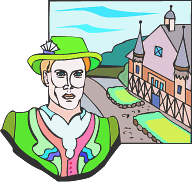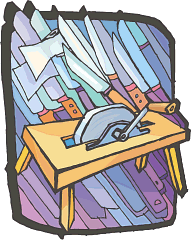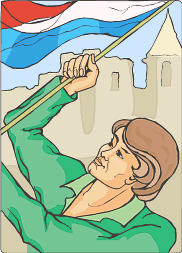 Charles Louis Eberle left home in his 17th year and went
down the Rhine to his uncle’s in Dusseldorf. He worked there
for about two years with a desire to go to France. He took lessons
in the French language. Leaving Dusseldorf, he proceeded to Bonn
on the Rhine. He worked there for awhile with one Dossler, then
took the road to France first through the Elsass. He worked at
Colmer with one Hochstaller, in Strasbourg with Mr. Bogner and
from there he started to Paris. In Paris he worked for one Morreaux
in Rue de la Harpe principally in fine pocket knives, scissors,
and penknives. After that he engaged with one Baumele mostly in
fine table knives and forks rivoted and capped with gold and silver
with ivory handles, rosewood, ebony, etc.; also dirks, knive in
scabbards, and a number of strait work. Charles Louis Eberle left home in his 17th year and went
down the Rhine to his uncle’s in Dusseldorf. He worked there
for about two years with a desire to go to France. He took lessons
in the French language. Leaving Dusseldorf, he proceeded to Bonn
on the Rhine. He worked there for awhile with one Dossler, then
took the road to France first through the Elsass. He worked at
Colmer with one Hochstaller, in Strasbourg with Mr. Bogner and
from there he started to Paris. In Paris he worked for one Morreaux
in Rue de la Harpe principally in fine pocket knives, scissors,
and penknives. After that he engaged with one Baumele mostly in
fine table knives and forks rivoted and capped with gold and silver
with ivory handles, rosewood, ebony, etc.; also dirks, knive in
scabbards, and a number of strait work.
 From there he went to Mons. Cuvier. There he worked in plain
razor line but they had to be good and warranted. Having become
good at what he did, he received a note from a Monsieur Mesman,
a surgical instrument maker on petit Marche proche Notre Dame
promising him employment only in instruments, which he accepted. From there he went to Mons. Cuvier. There he worked in plain
razor line but they had to be good and warranted. Having become
good at what he did, he received a note from a Monsieur Mesman,
a surgical instrument maker on petit Marche proche Notre Dame
promising him employment only in instruments, which he accepted.
During his employment with Mr. Mesman, the long dreaded revolution
broke out on 14 July 1789. He was forced out of his rented room
and forced to become a volunteer. He at first stormed the Hotel
of the Invalides, took arms and ammunition from there and marched
to the Bastile and took it in about two hours. They let all the
prisoners out, hung the Commandant, then toward evening the mob
dispersed. “This was short, dangerous and disagreeable work.
I hate to think about it.”
A few days later, the multitude went out to Versailles to
bring the King to Paris. They were armed with muskets, guns, axes,
spikes, dung forks, hay forks, and scythes straitened and put
on poles, large knives, etc. It looked dreadful. They took the
King of Paris to the Maison de Ville (State House) where he signed
a constitution and then returned again to Versailles.
 Nowhere did the military make any resistance. They all joined
the multitude. After this uproar subsided and some order reigned
again, M. Mesner opened his boutique and we all began work as
usual. After the King had left the city, there was a great illumination,
in particular the Maison de Ville was tastefully decorated, an
oblong square show the following illuminated inscription: ‘Louis
XVI Roi de Francais et peredun Poeple Libre.’ The old title
of the king was Louis XVI Roi de France et de Navarre. For a few
days the green cocade was used, afterwards blue, white, and red.
Now in September following a government order was published that
all those foreigners who intended to stay in France should swear
to the country, or quit it and passports should be given without
pay. Nowhere did the military make any resistance. They all joined
the multitude. After this uproar subsided and some order reigned
again, M. Mesner opened his boutique and we all began work as
usual. After the King had left the city, there was a great illumination,
in particular the Maison de Ville was tastefully decorated, an
oblong square show the following illuminated inscription: ‘Louis
XVI Roi de Francais et peredun Poeple Libre.’ The old title
of the king was Louis XVI Roi de France et de Navarre. For a few
days the green cocade was used, afterwards blue, white, and red.
Now in September following a government order was published that
all those foreigners who intended to stay in France should swear
to the country, or quit it and passports should be given without
pay.
Charles chose the last, took a passport, and left Paris about
the middle of September 1789. Several other Germans did the same
thing and went with him. After a march of ten days they arrived
safely in Strassbourg. There he tarried about four weeks, working
with Mr. Weber and made him several sets of Obstetrical instruments.
Toward the end of October, Charles left Strassbourg and in a few
days arrived safely at his parents in Dalheim.
Well, you can imagine this would be a wonderful find if it
did tie to the client’s family. The client had several Charles
Eberly individuals in his mother’s line, but the earliest
was one born in 1800 who married February 14th, 1824 by Rev. Hecht,
Charles Eberly to Miss Sarah Ann Barnet in Pennsylvania. He would
have been born about 1795/1800. He may have been the son of the
man above. First we had to determine if the facts in the papers
were correct. Were the years accurate for the events they were
describing? Yes. Did these addresses appear in Paris? Yes. Were
these events plausible? Yes.
These papers were giving the complete description, occupation,
relationships, etc., of the first immigrant to America. He goes
on to explain how the rest of the family arrived, and his marriage.
Marriage to Maria Catherine
Reuter
During the winter he applied for permission to settle in
Kirchheim, the residence of the Prince of Nassam Weilbourg. Having
received permission, he removed there early the following spring.
On 18 May 1790 he was married to Miss Maria Catherine Reuter daughter
of the late Philip Reuter and his wife Elizabeth born Rosman.
The father was a teacher at the Evangical Lutheran School in Oppenheim.
He died in 1784. The mother left the world when Maria Catherine
was but an infant. Philip Reuter was an intimate friend of Charles’
father and a distant relative.
The couple was established but a short time when the war
commenced between the Germans and the French. The French Army
took Metz. The German Prince over Charles, with his whole court,
left them and crossed the river. Charles principle dependency
was gone. There was nothing but battles, plundering and quartering
troops, German and French. Charles and Maria Catherine Eberle
never had less than two and sometime as many as 21 soldiers in
their house at one time and many other troubles.
 Metz was taken and retaken several times with the last being
in 1794. With the River Rhine cleared of troops by the retreat
of the French Army, and no prospects of peace appearing, Charles
resolved to emigrate with his small family to America. He informed
his brother-in-law Mattes who decided to go with them. So did
two of his brothers, George A. and Henry I. Eberle. Metz was taken and retaken several times with the last being
in 1794. With the River Rhine cleared of troops by the retreat
of the French Army, and no prospects of peace appearing, Charles
resolved to emigrate with his small family to America. He informed
his brother-in-law Mattes who decided to go with them. So did
two of his brothers, George A. and Henry I. Eberle.
Emigration from Germany
They were ready by the 26th of April and took leave of their
dear parents by sailing down the Rhine. In about a week they arrived
in the Haag in Holland and were put up at their brother Frederick’s
who was living in the city. There they remained until they heard
of the death of Charles’ father. 15 June when they went
to Ampsterdam to the ship Columbia, Capt Maldy Commander. On the
5th of September they arrived before Philadelphia. On the 12th
of September they left the ship and moved into the city. On
the 15th of September, Charles started work with Henry Schively
on 3rd below Chestnut street, a cutler. His two brothers found
employment at the Echfeldt son on 5th street, a First Rate Smith.
Charles continued with Mr. Schively until Spring, when in
company with his brothers they took a contract with the U. S.
to make bayonets and ramrods. They made in all about 3000 sets,
but did a good deal of other work as well.
Bringing the Family to America
Shortly after their arrival, they wrote to their mother
and desired her to come to America with the rest of the family.
This they did in the month of October 1796. He went to Baltimore
where he picked them up and brought them to Philadelphia. (Namely
his mother, sister Gertrude Meng, a widow with two children, both
Philip Peter and brother Frederick, his wife and a son Jacob from
the Haag. Now all the Eberles were in America.
This was a wonderful example of what can be found in a manuscript
collection. We checked with a linguist about the word order and
other details of the entire manuscript (which listed earlier grandparents
for several generations back). He concurred that it had been written
by someone who spoke German first, then some French, and English
last. Perhaps it was dictated by the man to his child. At any rate,
after much other research on all the people mentioned in the story,
several generations of the family were able to be linked together
through vital records, ship passenger lists, and other documents.
We shudder to think of what would have been lost if he had just
thrown out the papers. |
 Charles Louis Eberle left home in his 17th year and went
down the Rhine to his uncle’s in Dusseldorf. He worked there
for about two years with a desire to go to France. He took lessons
in the French language. Leaving Dusseldorf, he proceeded to Bonn
on the Rhine. He worked there for awhile with one Dossler, then
took the road to France first through the Elsass. He worked at
Colmer with one Hochstaller, in Strasbourg with Mr. Bogner and
from there he started to Paris. In Paris he worked for one Morreaux
in Rue de la Harpe principally in fine pocket knives, scissors,
and penknives. After that he engaged with one Baumele mostly in
fine table knives and forks rivoted and capped with gold and silver
with ivory handles, rosewood, ebony, etc.; also dirks, knive in
scabbards, and a number of strait work.
Charles Louis Eberle left home in his 17th year and went
down the Rhine to his uncle’s in Dusseldorf. He worked there
for about two years with a desire to go to France. He took lessons
in the French language. Leaving Dusseldorf, he proceeded to Bonn
on the Rhine. He worked there for awhile with one Dossler, then
took the road to France first through the Elsass. He worked at
Colmer with one Hochstaller, in Strasbourg with Mr. Bogner and
from there he started to Paris. In Paris he worked for one Morreaux
in Rue de la Harpe principally in fine pocket knives, scissors,
and penknives. After that he engaged with one Baumele mostly in
fine table knives and forks rivoted and capped with gold and silver
with ivory handles, rosewood, ebony, etc.; also dirks, knive in
scabbards, and a number of strait work.  From there he went to Mons. Cuvier. There he worked in plain
razor line but they had to be good and warranted. Having become
good at what he did, he received a note from a Monsieur Mesman,
a surgical instrument maker on petit Marche proche Notre Dame
promising him employment only in instruments, which he accepted.
From there he went to Mons. Cuvier. There he worked in plain
razor line but they had to be good and warranted. Having become
good at what he did, he received a note from a Monsieur Mesman,
a surgical instrument maker on petit Marche proche Notre Dame
promising him employment only in instruments, which he accepted. Nowhere did the military make any resistance. They all joined
the multitude. After this uproar subsided and some order reigned
again, M. Mesner opened his boutique and we all began work as
usual. After the King had left the city, there was a great illumination,
in particular the Maison de Ville was tastefully decorated, an
oblong square show the following illuminated inscription: ‘Louis
XVI Roi de Francais et peredun Poeple Libre.’ The old title
of the king was Louis XVI Roi de France et de Navarre. For a few
days the green cocade was used, afterwards blue, white, and red.
Now in September following a government order was published that
all those foreigners who intended to stay in France should swear
to the country, or quit it and passports should be given without
pay.
Nowhere did the military make any resistance. They all joined
the multitude. After this uproar subsided and some order reigned
again, M. Mesner opened his boutique and we all began work as
usual. After the King had left the city, there was a great illumination,
in particular the Maison de Ville was tastefully decorated, an
oblong square show the following illuminated inscription: ‘Louis
XVI Roi de Francais et peredun Poeple Libre.’ The old title
of the king was Louis XVI Roi de France et de Navarre. For a few
days the green cocade was used, afterwards blue, white, and red.
Now in September following a government order was published that
all those foreigners who intended to stay in France should swear
to the country, or quit it and passports should be given without
pay.  Metz was taken and retaken several times with the last being
in 1794. With the River Rhine cleared of troops by the retreat
of the French Army, and no prospects of peace appearing, Charles
resolved to emigrate with his small family to America. He informed
his brother-in-law Mattes who decided to go with them. So did
two of his brothers, George A. and Henry I. Eberle.
Metz was taken and retaken several times with the last being
in 1794. With the River Rhine cleared of troops by the retreat
of the French Army, and no prospects of peace appearing, Charles
resolved to emigrate with his small family to America. He informed
his brother-in-law Mattes who decided to go with them. So did
two of his brothers, George A. and Henry I. Eberle.